
This parent guide supports parents in helping their child at home with the 6th grade Science content.
- Subject:
- Science
- Material Type:
- Reference Material
- Vocabulary
- Author:
- Kelly Rawlston
- Letoria Lewis
- Date Added:
- 10/11/2022

This parent guide supports parents in helping their child at home with the 6th grade Science content.

This resource accompanies our Rethink 6th Grade Science course. It includes ideas for use, ways to support exceptional children, ways to extend learning, digital resources and tools, tips for supporting English Language Learners and students with visual and hearing impairments. There are also ideas for offline learning.

Students use light bulbs shining on a shiny can vs a black can and a beaker of water vs a beaker of soil to compare heating and cooling rates.
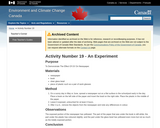
Students demonstrate the effect of UV on newspaper.

Students use a UV meter to monitor UV over a period of several hours and correlate it to atmospheric conditions. After collecting data, students will create a graph and also compare their data to the day's UV index forecast.

Students demonstrate the importance of reducing direct UV exposure and illustrate the degree of protection provided by various sources of shade.
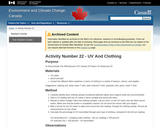
Students demonstrate the effectiveness of a variety of fabrics on reducing UV.

Students demonstrate the rate at which the sun's energy is absorbed is affected by the color of a material.

Students use thermometers, white and dark paper, and lamps to measure differences in albedo between the light and dark materials.

In this lesson, students create a greenhouse gas, carbon dioxide, through a simple chemical reaction, measure the effect of the gas on air temperature, and relate their findings to the greenhouse effect in our atmosphere.

In this lesson, students conduct an experiment to help students understand that ultraviolet radiation is present in natural outdoor light and that the intensity of the light varies with season and time of day.

Students will create a solar oven from a pizza box. They will learn that the sun is hot enough to bake food through warming up the ingredients for smores.

In this STEM lesson, students will participate in an engineering design challenge to design and build a solar box cooker, and test it out to see if it works well enough to make S'mores.
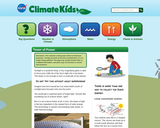
This article describes a form of solar energy collection called concentrating solar power and explains the basic technology behind it. A supplemental column provides a brief overview of three other solar collections systems. The Climate Kids website is a NASA education resource featuring articles, videos, images and games focused on the science of climate change.

In this activity, students will examine how ectothermic animals, such as ghost crabs, regulate their body temperature by moving to different environments.

In this STEM activity, students are enabled to demonstrate, test, and analyze materials utilized in spacesuits to keep astronauts cool in the harsh environment of space. They will demonstrate the water cooling technology used in the International Space Station (ISS) Extravehicular Mobility Unit (EMU). Students will also test and make an analysis of the relationship between reflection/absorption and color.
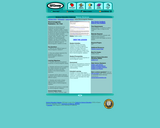
In this lesson, students are introduced to the properties of electromagnetic radiation. Students create a “Quipo,†a method used by the ancient Incas. Students are also encouraged to use an electronic bulletin board to communicate with each other, post insights, ideas, evidence, and questions on electromagnetic radiation. As part of this activity, students will conduct a mock trial placing the different types of electromagnetic radiation on trial.
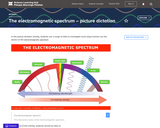
In this picture dictation activity, students use a range of skills to investigate some ways humans use the waves on the electromagnetic spectrum.

Students design and build a solar water heater and see how big a temperature change they can get.

Students observe how temperature changes when jars are left in a sunny window. They will then relate their observations to the greenhouse effect.